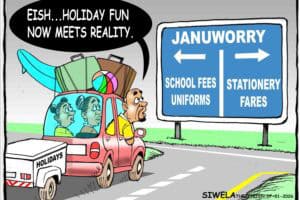Despite lower fuel prices, even middle class South African consumers continue to battle to afford essentials and make ends meet.

The fuel price cuts are no cause for celebration as South Africans become increasingly poorer as they continue to pay more for food and other essentials, have a high debt-to-income ratio and many of them cannot find work.
From today you will pay R21.79 for a litre of 93 unleaded and R22.19 per litre for 95 unleaded, the lowest prices seen yet in 2024, bringing welcome relief to motorists and commuters, but the cuts are not nearly enough to make a dent in food prices or the price of other essential household goods.
It will also make no discernible difference to the lives of over half of the South African population (55%) who are currently mired in poverty, Neil Roets, CEO of Debt Rescue, says.
“Statistics SA’s latest General Household Survey paints an ugly picture of approximately 24 million people in the country living below the poverty line and surviving on government grants. In fact, an estimated 50% of all households in the country now receive at least one social grant, with grants being the main source of income for 23% of households nationally.”
Roets says this is deeply concerning. “The National Assembly recently passed the 2024 Appropriation Bill, which will increase social transfers by nearly R50 billion to over R300 billion for the year. With unemployment now at 33.5%, the highest in two years, surely we should be allocating these billions to creating work opportunities to enable more people to join the workforce and contribute to the tax base in the country?”
ALSO READ: Poverty line shift: This is how much SA’s poor need to survive in 2024
Most South Africans live under poverty line
Statistics SA’s updated poverty lines for 2024 show an increase in the food poverty line, commonly referred to as the extreme poverty line, from R760 per person per month in 2023 to R796 in 2024, an increase of R36. This is the amount of money a person needs to afford the minimum required daily energy intake.
“It is very difficult to rejoice in saving a few hundred rand per month on petrol or transport costs when millions of our fellow citizens are trapped in daily misery and hunger, with no hope of crossing the poverty line,” Roets says.
“Even poor consumers surviving below or on the upper-bound poverty line of R1 634 are unable to buy anywhere near the amount of nutritional food needed to stay strong and healthy. Should this not be a top priority for the country’s leaders and food retailers right now? We simply cannot allow this to become the ‘new normal’.”
ALSO READ: South Africans rely on payday loans to afford electricity and fuel
Middle class now also poor consumers
The middle class is also not spared, he says. “The financial challenges South Africa’s middle class faces continue to intensify, with people facing unsustainable levels of household debt, particularly those earning R20 000 or more per month.
“This income bracket is burning through credit to make ends meet and through no fault of their own. These are hardworking citizens who, until a few short years ago, could afford to buy and pay off a house and a vehicle, while living comfortably on their monthly salaries.
“Not anymore. Now, the interest on home and car loans has simply pushed them out of this bracket and coupled with diminishing disposable income, due to salaries not keeping up with inflation, escalating prices of basic necessities like electricity, water and food costs skyrocketing, they are floundering in a sea of debt.”
ALSO READ: Why consumers have too much month left at the end of the money
High household debt-to-income ratio
The household debt-to-income ratio is projected to hover around an astounding 65% in 2024, with South Africans spending up to 75% of their income on servicing debt, more than at any time in the last five years according to the South African Reserve Bank (Sarb).
“This is no surprise with the prime lending rate increased by 475 basis points since November 2021 to 11.75%, driving debt levels into an unsustainable realm. We are seeing the repercussions of this in the escalating number of people applying for debt counselling.
“With the new two-pot retirement system now implemented, pension fund contributors who are among the indebted will likely withdraw as much as they can from their retirement savings, reducing the value of their future nest egg and spending the money they can now access just to keep up with day-to-day needs, or worse, paying off their debt,” Roets says.






